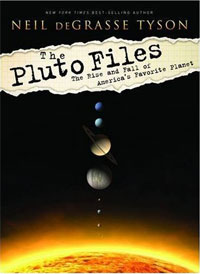(S)ex objectsby Taylor Dinerman
|
| Even if Tyson had not been intimately involved in the debate of Pluto’s status, it would only be natural for him to have his say. |
The human habit of categorizing and labeling everything in existence is an old one, he notes, as “early literate cultures produced large quantities of written inventories and other kinds of lists.” What was good for the ancient Babylonians and Egyptians would certainly seem to be good enough for contemporary scientists. However, the process has been challenged by a number of post-structuralists and other literary theorists who believe that the scientific process itself represents an example of western imperialist aggression.
In any case, the Pluto’s loss of its status as the ninth planet has been painful for some, but not without humor. Tyson sprinkles a selection of some of the best Plutonian cartoons, song lyrics and commentary throughout the book. For example, in February 2001, the incomparable Eric Metaxas wrote about some of the implications of Pluto’s loss of status in the New York Times:
TROPICS OF CAPRICORN AND CANCER TO BE ABOLISHED
TOMATO UNEQUIVOCALLY DECLARED A VEGETABLE
BEIGE TAUPE AND MAUVE LOSE COLOR STATUS
METER AND YARD SHAKE HANDS
TAB AND ZIMA LOSE BEVERAGE STATUS
If Pluto is no longer a planet maybe the universe really is spinning out of control?
If Pluto is not a planet, how did it get to be one in the first place? As Tyson explains it’s all due to a massive miscalculation. Percival Lowell, the great and often weird early 20th century astronomer, believed that beyond Neptune there had to exist something he called “Planet X”. Otherwise, he could not account for certain perturbations he had found in the orbits of Neptune and Uranus. After his death in 1916 the observatory he founded took up the search and in the late 1920s hired a young amateur astronomer named Clyde Tombaugh to look for the planet that they were sure was out there. In 1930 he found it, and it was eventually named Pluto. A few months later Walt Disney decided that Mickey Mouse’s dog should be named Pluto the Pup, so whatever it is, Pluto the celestial object has precedence over Pluto the cartoon character.
Sadly, in 1993 a stake was driven through the “Planet X” theory when E. Myles Standish Jr. of JPL published a paper. Using data from the Voyager flybys of the 1980s he recalculated the masses of the outer gas giants and presto: “The misbehaving trends in the paths of Uranus and Neptune disappeared completely, and their orbits could be explained entirely within the gravitational landscape of the presently known solar system. In plain English Planet X was dead.”
Of course, the Kuiper Belt was still out there and, unfortunately for Pluto’s planetary status, it is populated with a number of objects that proved to be all too similar to what we had been brought up to believe was the ninth planet. It is now assumed that the celestial debris out there is leftover junk from the creation of the solar system, too close to the Sun to drift into interstellar space, but too far away to be sucked into the orbits of the “real” planets.
| One of the great joys of science is that it gives us the chance to listen to some extremely smart people disagreeing with each other. |
So what are they? Some have called them Trans Neptunian Objects (TNOs), while others call them Kuiper Belt Objects. The International Astronomical Union meeting in Prague in August 2006 voted to call Pluto a “dwarf planet”. Others think that it’s just a “dirty iceball” or an “icy dirtball”, depending on the results of NASA’s New Horizon mission scheduled to reach the place in 2015.
One of the great joys of science is that it gives us the chance to listen to some extremely smart people disagreeing with each other. When it’s done with good humor and gentleness, as has been the case with the debate over Pluto, everyone can walk away from the debate feeling a bit wiser and eager to enlarge their knowledge. When things get political, then the fights become bitter and the words of Soviet dictator Joseph Stalin start ringing in our ears: “Bravo, Comrade Lysenko, Bravo!”
